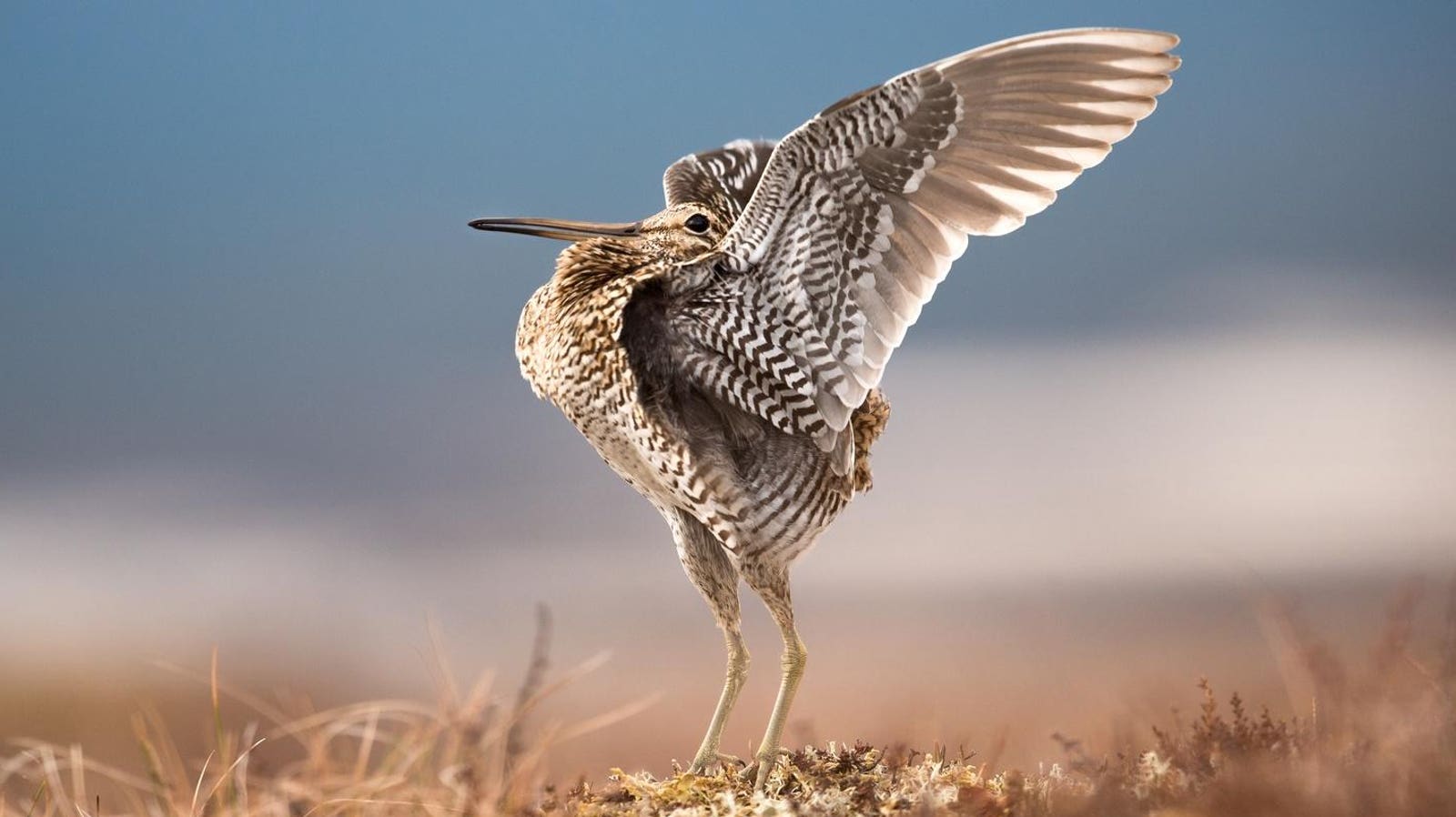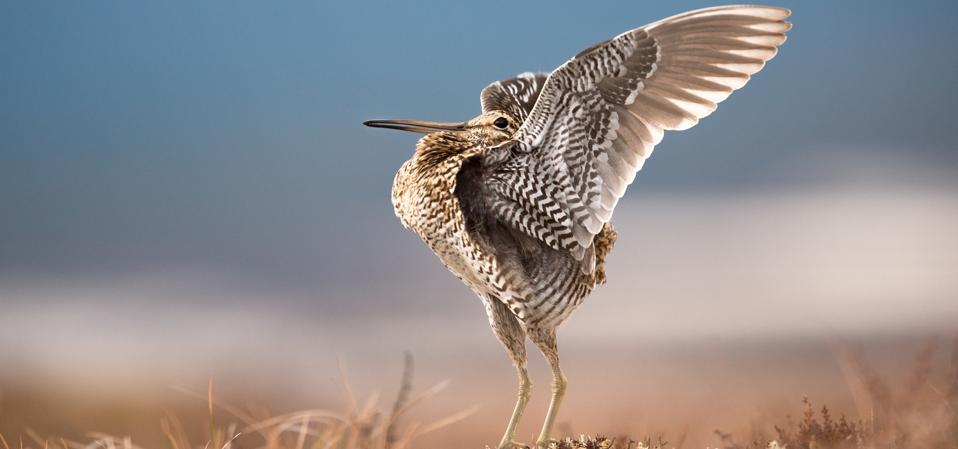Migratory birds are some of nature’s most efficient travelers, able to cross oceans and continents … More
The great snipe (Gallinago media) is a master of stamina and endurance. It is a migratory bird who spends its winters in sub-Saharan Africa and its summers in northern Europe or northwestern Russia. And it wastes no time travelling from one pied-à-terre to the other – sometimes completing the trek in as little as 60 hours.
That’s a statistic so impressive it deserves additional context. Imagine you’re a human in central Africa and your goal is to get to north-central Sweden as quickly as possible. One way to do it would be to travel by bus or car to Bangui M’Poko International Airport in the Central African Republic. From there, you could hop on an Ethiopian Airlines plane that would fly to Addis Ababa for a layover, then up to Stockholm. That would take you about a day with some luck. Then, you’d need to grab another flight to the northern part of Sweden, followed by a car or bus ride to your final destination. Realistically, we’re talking about two days of travel, minimum.
And how about for the great snipe? It flies a direct route, traveling day and night, at speeds of up to 60 miles per hour – and makes no stops, not even for a water break. Depending on conditions, it does the trip in 60 to 90 hours. In other words, it probably beats humans, with modern transportation means at their disposal, 10 or 20% of the time (cancellations, delays, etc.). That’s incredible.
Not surprisingly, scientists have spent considerable time studying the migratory efficiency of the great snipe. Here are three scientific reasons why the bird is able to travel so far so fast.
1. The Great Snipe Climbs to Extreme Altitudes to Stay Cool and Avoid Overheating
A great snipe displays on its summer breeding grounds in northern Europe.
Before diving into how the great snipe migrates so efficiently, it’s worth meeting the bird itself. The great snipe (Gallinago media) is a medium-sized, stocky shorebird with intricately patterned brown, black, and white plumage that provides camouflage in grasslands and wetlands. Males are slightly smaller than females and are known for dramatic courtship displays involving rapid wing beats and vocal trills. Despite their relatively compact bodies, roughly the size of a pigeon, they’re among the most extreme endurance athletes in the animal kingdom.
One of their most remarkable flight adaptations is their ability to ascend to high altitudes during daytime migration. Tracked birds regularly fly at heights above 20,000 feet, with one individual reaching 28,000 feet, one of the highest altitudes ever documented for a flapping migratory bird. Why such extreme heights? The answer lies in managing body temperature. At lower daytime altitudes, direct sunlight can cause overheating. Birds can’t sweat, so they rely on evaporative cooling, which risks dehydration during nonstop flights. By climbing to colder air, where temperatures can drop well below freezing, great snipes naturally cool their bodies through convection, conserving water and maintaining optimal function.
(Sidebar: The great snipe is among the highest flyers in the bird world – but not the highest. That record goes to a bird that once collided with a commercial jet at 37,000 feet. Read about it here.)
2. The Great Snipe Flies Higher During the Day to Avoid Predators
One great snipe was recorded migrating at an altitude of 28,000 feet, enduring extreme cold, low … More
Another reason behind the great snipe’s impressive migratory performance is its ability to avoid aerial predators by adjusting its flight altitude depending on the time of day. During daylight hours, raptors like Eleonora’s falcon and peregrine falcon actively hunt small to medium-sized birds. These predators typically patrol altitudes below 10,000 feet, especially around dawn when their prey begins flying again after nighttime rest. By climbing well above these altitudes, the great snipe puts itself out of reach of most of these hunters.
Interestingly, the snipe’s daily altitude cycle reflects this risk management strategy. After flying at lower altitudes during the relative safety of night, it ascends at dawn, reaching altitudes that make predation much less likely. Then, as the sun sets and predator activity drops, the birds descend again to more oxygen-rich, energy-efficient air layers for night flight. This up-and-down flight pattern isn’t just about staying cool; it’s about staying alive.
3. Altitude Changes May Help Great Snipes Navigate Using Landmarks
The great snipe forages in wet meadows and marshes, probing soft soil for invertebrates such as … More
Efficiency in migration is as much about accurate navigation as it is about endurance. Here, a third factor comes into play: the great snipe’s need to orient itself using Earth’s surface features.
During daylight, flying at higher altitudes provides the great snipe with a broader, more detailed view of the landscape below. This enhanced perspective can be crucial for maintaining direction, identifying key ecological landmarks, or adjusting course over long stretches of terrain such as the Sahara or the Mediterranean.
Though many birds navigate using the stars, the sun, Earth’s magnetic field, or even olfactory cues, visual landmarks are still important. By climbing higher during the day, great snipes may be able to detect distant rivers, coastlines, or other familiar features, aiding in precise navigation over thousands of kilometers. At night, when visibility drops, these landmarks are harder to see, so there’s less reason to remain at higher, less oxygen-rich elevations. As a result, the birds descend into more comfortable altitudes to conserve energy.
Are you an animal lover who owns a pet, perhaps even a pet bird? Take the science-backed Pet Personality Test to know how well you know your little friend.









